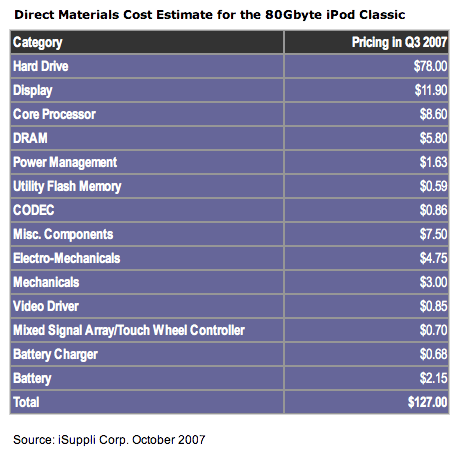iPod classic: the last hurrah for HDD-based iPods?
Echoing sentiments first outlined in AppleInsider's review of the iPod Classic, the market intelligence firm believes the player's days may be numbered, as sales of the Classic are expected to begin their slow and inevitable decline beginning sometime next year.
"Apple’s continuation of the iPod model without adding new features suggests a stopgap measure necessitated by lack of time to develop an HDD-based touch iPod," said consumer electronics Chris Crotty.
Still, the Cupertino-based firm has seemingly managed to squeeze additional gross margin from the new Classic line when compared to last year's offerings, despite its uncharacteristic backward-looking approach to the player.
The new iPod classic carries a Bill of Materials (BOM) of $127 for the 80Gbyte version, and about $190 for the 160Gbyte model, according to iSuppli’s teardown of the players. This includes estimated costs of $78 for the 80Gbyte HDD in the low-end classic and $140 for the 160Gbyte HDD in the high-end model. That means the new 80Gbyte model sports a BOM that is 11.2 percent lower than that of the company's 30Gbyte model ($143) released last year.
However, the Classic’s dated features suggest stopgap measures that are likely to limit the product’s longevity and success in the market, iSuppli believes. The firm tentatively forecasts that iPod Classic shipments will start with a bang this holiday, rising to about 3.1 million units in 2007. However, growth will likely slow markedly after that, with shipments rising by only 12.9 percent to reach 3.5 million in 2008.
In contrast, combined shipments of the new NAND flash memory-based iPod nano and touch models are expected to amount to 26 million units in 2007, rising to nearly 40 million units in 2008 — a 52 percent increase. iSuppli believes Apple will continue to take advantage of the 50 to 60 percent annual reductions in flash memory pricing to maintain or decrease its production costs, while doubling its players’ storage capacity every year with the solid-state storage technology as the HDD iPod slowly fades into the distance.
 Slash Lane
Slash Lane











 Malcolm Owen
Malcolm Owen
 William Gallagher and Mike Wuerthele
William Gallagher and Mike Wuerthele
 Christine McKee
Christine McKee
 William Gallagher
William Gallagher

 Marko Zivkovic
Marko Zivkovic









